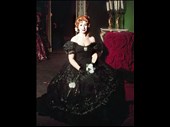Solution for: The History of Early Cinema
Answer Table
| 1. A, D, F IN ANY ORDER | 8. C |
| 2. A, D, F IN ANY ORDER | 9. H |
| 3. A, D, F IN ANY ORDER | 10. C |
| 4. cartoons, serials | 11. A |
| 5. (slapstick) comedy / slapstick | 12. F |
| 6. (the) avant(-)grade (film(s)) | 13. D |
| 7. A |
Exam Review
The History of Early Cinema

The history of the cinema in its first thirty years is one of major and, to this day, unparalleled expansion and growth. Beginning as something unusual in a handful of big cities - New York, London, Paris and Berlin - the new medium quickly found its way across the world, attracting larger and larger audiences wherever it was shown and replacing other forms of entertainment as it did so. As audiences grew, so did the places where films were shown, finishing up with the ‘great picture palaces’ of the 1920s, which rivalled, and occasionally superseded, theatres and opera-houses in terms of opulence and splendour. Meanwhile, films themselves developed from being short ‘attractions’ only a couple of minutes long, to the full-length feature that has dominated the world's screens up to the present day.
Although French, German, American and British pioneers have all been credited with the invention of cinema, the British and the Germans played a relatively small role in its worldwide exploitation, It was above all the French, followed closely by the Americans, who were the most passionate exporters of the new invention, helping to start cinema in China, Japan, Latin America and Russia. In terms of artistic development it was again the French and the Americans who took the lead, though in the years before the First World War, Italy, Denmark and Russia also played a part.
In the end, it was the United States that was to become, and remain, the largest single market for films. By protecting their own market and pursuing a vigorous export policy, the Americans achieved a dominant position on the world market by the start of the First World War. The centre of film-making had moved westwards, to Hollywood, and it was films from these new Hollywood studios that flooded onto the world's film markets in the years after the First World War, and have done so ever since. Faced with total Hollywood domination, few film industries proved competitive. The Italian industry, which had pioneered the feature film with spectacular films likeQuo vadis? (1913) and Cabiria (1914), almost collapsed. In Scandinavia, the Swedish cinema had a brief period of glory, notably with powerful epic films and comedies. Even the French cinema found itself in a difficult position. In Europe, only Germany proved industrially capable, while in the new Soviet Union and in Japan the development of the cinema took place in conditions of commercial isolation.
Hollywood took the lead artistically as well as industrially. Hollywood films appealed because they had better-constructed narratives, their special effects were more impressive, and the star system added a new dimension to screen acting. If Hollywood did not have enough of its own resources, it had a great deal of money to buy up artists and technical innovations from Europe to ensure its continued dominance over present or future competition.
The zest of the world survived partly by learning from Hollywood and partly because audiences continued to exist for a product which corresponded to needs which Hollywood could not supply. As well as popular audiences, there were also increasing audiences for films which were artistically more adventurous or which dealt with the issues in the outer world.
None of this would have happened without technology, and cinema is in fact unique as an art form. In the early years, this art farm was quite primitive, similar to the original French idea of using a lantern and slides back in the seventeenth century. Early cinema programmes were a mixture of items, combining comic sketches, free-standing narratives, serial episodes and the occasional trick or animated film. With the arrival of the feature length narrative as the main attraction, other types of films became less important. The making of cartoons became a separate branch of film-making, generally practised outside the major studios, and the same was true of serials. Together with newsreels, they tended to be shown as short items in a programme which led to the feature.
From early cinema, it was only Americana slapstick comedy that successfully developed in both short and feature format. However, during this 'Silent Film' era, animation, comedy, serials and dramatic features continued to thrive, along with factual films or documentaries, which acquired an increasing distinctiveness as the period progressed. It was also at this time that the avant-garde film first achieved commercial success, this time thanks almost exclusively to the French and the occasional German film.
Of the countries which developed and maintained distinctive national cinemas in the silent period, the most important were France, Germany and the Soviet Union. Of these, the French displayed the most continuity, in spite of the war and post-war economic uncertainties. The German cinema, relatively insignificant in the pre-war years, exploded on to the world scene after 1919. Yet even they were both overshadowed by the Soviets after the 1917 Revolution. They turned their back on the past, leaving the style of the pre-war Russian cinema to the emigres who fled westwards to escape the Revolution.
The other countries whose cinemas changed dramatically are: Britain, which had an interesting but undistinguished history in the silent period; Italy, which had a brief moment of international fame just before the war; the Scandinavian countries, particularly Denmark, which played a role in the development of silent cinema quite out of proportion to their small population; and Japan, where a cinema developed based primarily on traditional theatrical and, to a lesser extent, other art forms and only gradually adapted to western influence.
Great thanks to volunteer Ratphan has contributed these explanations markings.
If you want to make a better world like this, please contact us.
Questions 1-3
Which THREE possible reasons for American dominance of the film industry are given in the text?
A plenty of capital to purchase what it didn't have
B making films dealing with serious issues
C being first to produce a feature film
D well-written narratives
E the effect of the First World War
F excellent special effects.
1. Answer: A, D, F IN ANY ORDER Locate
2. Answer: A, D, F IN ANY ORDER
3. Answer: A, D, F IN ANY ORDER
Questions 4-6
Answer the questions below using NO MORE THAN THREE WORDS from the passage for each answer.
Write your answers in boxes 4-6 on your answer sheet.
Answer: cartoons, serials Locate
Answer: (slapstick) comedy / slapstick Locate
Answer: (the) avant(-)grade (film(s)) Locate
Questions 7-13
Look at the following statements (Questions 7-13) and the list of countries below.
Match each statement with the correct country.
Write the correct letter A-J in boxes 34-40 an your answer sheet.
NB You may use any letter more than once.
| List of Countries | ||||||||||||||||||||
|
Other Tests
-
Total questions: 13
- 4- Multiple Choice
- 4- Matching Headings
- 5- Summary, form completion
-
Total questions: 13
- 4- TRUE-FALSE-NOT GIVEN
- 5- Matching Information
- 4- Sentence Completion
-
Total questions: 13
- 5- TRUE-FALSE-NOT GIVEN
- 4- Matching Information
- 4- Summary, form completion
-
Total questions: 14
- 13- Matching Information
- 1- Sentence Completion
-
Total questions: 13
- 2- Multiple Choice
- 7- Matching Headings
- 4- Sentence Completion
-
Total questions: 14
- 4- YES-NO-NOT GIVEN
- 4- Matching Headings
- 6- Sentence Completion











